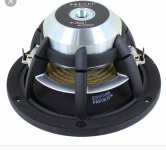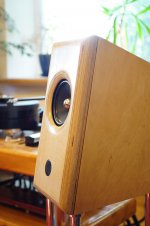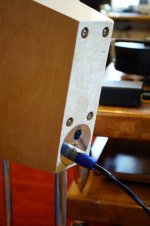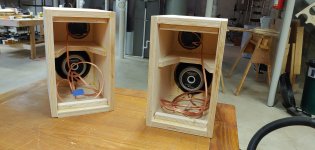I am constructing a 2 way with satori MW13P-8 and SB26ADC tweeter (will be assisted by a subwoofer). Its is my first serious build but as I lack time for trial and error I want to make things right as much as I can.
In several threads I've read that magnet mounting a midrange (and even woofers) improve sound reception considerably and lowers unwanted output from the cabinet.
Now, this is usually done by clamping the magnet in some kind of frame but when one looks at satori midwoofers they have no flat surface to clamp. On the other hand these sport bolt hole protrusions in the chassis and reduced coupling between chassis and magnet. So, I have two doubts - has anyone mounted a satori midwoofer by the magnet and if so then how was it done? And secod question - is it worth the extra effort considering that vibration coupling form the driver chassis to cabinet and magnet has been addressed by design to some degree?
Any input is much appreciated.
In several threads I've read that magnet mounting a midrange (and even woofers) improve sound reception considerably and lowers unwanted output from the cabinet.
Now, this is usually done by clamping the magnet in some kind of frame but when one looks at satori midwoofers they have no flat surface to clamp. On the other hand these sport bolt hole protrusions in the chassis and reduced coupling between chassis and magnet. So, I have two doubts - has anyone mounted a satori midwoofer by the magnet and if so then how was it done? And secod question - is it worth the extra effort considering that vibration coupling form the driver chassis to cabinet and magnet has been addressed by design to some degree?
Any input is much appreciated.
Attachments
Hi Milus,
Whenever possible, I use magnet mounting with drivers, only softly coupling the driver to the front baffle. Although I haven´t done it with Satori drivers, I could imagine 2 possible ways to to it:
1. Glue several ring segments made of wood to the back of the magnet, allowing to screw down the magnet from behind. Segmented because you must be very careful not to block the rear vent.
2. Clamp the driver between front baffle and an internal brace, again careful not to block the vent. That means that you´ll "mount" it to the baffle from behind. This requires quite some efforts to avoid additional diffraction, but that´s worth it. You could also mount/fix the front baffle from the back and decouple same from the enclosure.
Some photos might hopefully explain a little more.
All the best
Mattes
Whenever possible, I use magnet mounting with drivers, only softly coupling the driver to the front baffle. Although I haven´t done it with Satori drivers, I could imagine 2 possible ways to to it:
1. Glue several ring segments made of wood to the back of the magnet, allowing to screw down the magnet from behind. Segmented because you must be very careful not to block the rear vent.
2. Clamp the driver between front baffle and an internal brace, again careful not to block the vent. That means that you´ll "mount" it to the baffle from behind. This requires quite some efforts to avoid additional diffraction, but that´s worth it. You could also mount/fix the front baffle from the back and decouple same from the enclosure.
Some photos might hopefully explain a little more.
All the best
Mattes
Attachments
I am constructing a 2 way with satori MW13P-8 and SB26ADC tweeter (will be assisted by a subwoofer).
That is an excellent combination, you should be able to achieve an excellent result.
Bracing the magnet is a construction technique that I would classify as "third order importance". It will only matter if you have done an excellent job at optimizing all of the more important parameters.
First order importance are things like on- and off-axis frequency response, dispersion, directivity control, and low bass extension. If you don't get this right, nothing else really matters.
Second order importance are things like very low diffraction, low distortion, avoiding diaphragm breakup, minimal cabinet resonances. Assuming you got the first order stuff well done, the second order stuff can make a difference.
Third order are things like extravagant or exotic cabinet construction, interior shape of the midrange cavity, the quality of capacitors, and yes magnet bracing. If you did everything else right, these third order parameters might make a very slight difference.
Now for your specific case, a Satori MW13P is going to require a fairly small cabinet. Cabinet structural resonances are easy to avoid with small cabinets. If you use 3/4 inch material for all cabinet walls, and double thickness for the baffle (1.5 inch), you should be fine That 5 inch driver will be effectively restrained by a thick 1.5 inch baffle. I would add a shelf type brace between the woofer and tweeter to restrain the weak area of the baffle. In my picture I have a ~ 12 liter box constructed exactly as I have described, but with a 6 inch driver. No resonances...
Attachments
Mattes, those are lovely looking pictures. THanks for Your input, but it doesn't get any easier, as satoris generally don't have flat chassis on the front, it gets thicker closer to the outer edge. And what would be the benefit to mount the front baffle to the back baffle? I planned to use fillets under the front baffle and put a decoupling layer between the fillets and front baffle, and then screw it together, I guess that ould give a similar effect.
hifijim - thanks for good piece of advise. I would like to think that I'm getting first and second order stuff right, internal shapes won't be any exotic but I paid attention to internal resonances and ways to combat/avoid them.
The cabinet wont be that small because it will be a floorstander with a chamber for the midwoofer and tweeter (since SB26AD has a closed chamber by design). But I plan to brace it extensively, pretty much the way You posted to reinforce front baffle between driver cutouts, especially since I shoot for as tight spacing as I can get. But besides front baffle bracing should go horizontal, along cabinet wall's longer dimension, not the shorter one. There's a diyaudio wiki on bracing and thats where I got this idea, I can find a link to it if You're interested. You have a very nice place for woodworking by the way.
hifijim - thanks for good piece of advise. I would like to think that I'm getting first and second order stuff right, internal shapes won't be any exotic but I paid attention to internal resonances and ways to combat/avoid them.
The cabinet wont be that small because it will be a floorstander with a chamber for the midwoofer and tweeter (since SB26AD has a closed chamber by design). But I plan to brace it extensively, pretty much the way You posted to reinforce front baffle between driver cutouts, especially since I shoot for as tight spacing as I can get. But besides front baffle bracing should go horizontal, along cabinet wall's longer dimension, not the shorter one. There's a diyaudio wiki on bracing and thats where I got this idea, I can find a link to it if You're interested. You have a very nice place for woodworking by the way.
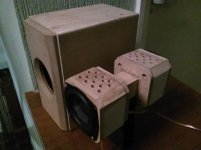
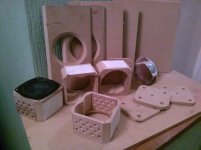
Another way to isolate the driver vibrations from the main cabinet, is to have the mid in it's own separate enclosure, inside the main cabinet and mechanically isolated ( with soft foam or felt ) from it, this should also stop the sound inside the mid box transmitting through the walls of the main cabinet. I've done this a few times, the pictures are of the latest ( and smallest ) examples that I've made using this idea, on these particular speakers the full range drivers are mounted back to back to try to cancel out the forces. I've previously used the same idea ( box within a box ) for mid/bass drivers. The main problem is you need a hole ( and cover ) to get the box inside.
You probably only will have to dampen transmission in the 500-2000Hz range (check with measurements if you like), because panel resonances will likely occur in that range. Decoupling the driver from the baffle, either with a suspended sub-baffle or with a gasket and grommets on the mounting bolts could do just fine here. The resonance frequency of the subsystem on the enclosure should be not too high, but anywhere between 50 and 200Hz would be OK.
The reason for magnet mounting is explained here Issues in speaker design - 2 It's probably not necessary for that driver. I'd suggest you just decouple it from the cabinet.
Hi Milus,
Sorry, forgot about the special baffle ring shape, although I still have Satoris somewhere in my workshop...
With these drivers, I think I would just have the screws biting in hardened silicone or something, have a soft gasket, apply minimum pressure (it´s a light driver) and be done. Don´t forget to chamfer the cutout inner edge.
All the best
Mattes
Sorry, forgot about the special baffle ring shape, although I still have Satoris somewhere in my workshop...
With these drivers, I think I would just have the screws biting in hardened silicone or something, have a soft gasket, apply minimum pressure (it´s a light driver) and be done. Don´t forget to chamfer the cutout inner edge.
All the best
Mattes
In several threads I've read that magnet mounting a midrange (and even woofers) improve sound reception considerably and lowers unwanted output from the cabinet.
The magnet experiences a reaction force to the acceleration of the mass of the air/cone/coil assembly. Ideally the magnet should be held fixed but in practice it moves slightly subtracting a small amount of motion from the cone. This follows from Newton's 2nd law and the relative masses of the air/cone/coil assembly and the magnet, magnet+frame or magnet+frame+enclosure depending on stiffnesses and mounting arrangements. The SL link is misleading because it doesn't consider the stiffness of the frame and baffle which usually have resonances within the passband. It also assumes the motion of the magnet follows the reaction force which it won't once in motion. It is probably more reasonable to consider the motion unwanted in the manner of distortion and to estimate the size from the relative masses involved.
If you manage to attach some form of clamp to the magnet and then attach that clamp to, say, the middle of the rear panel then work will be put into the cabinet structure via the rear panel. That (rate of) work will be the force * velocity of the rear panel at the mounting position. If the mounting is over a small area in the middle of the rear panel where it is relatively easy to move then you are likely to be putting more work into vibrating the cabinet not less compared to a a conventional mount on the front baffle. The approach works well if you have something stiff to mount to, heavy (see previous paragraph) and preferably isolated from the cabinet that radiates sound into the room. Can you see how to achieve this with a 2 way?
Last edited:
The cabinet wont be that small because it will be a floorstander with a chamber for the midwoofer and tweeter
OK I misunderstood, I thought you were building a pair of small 2-ways plus a subwoofer. What woofer (or subwoofer) do you plan to use? I look forward to hearing about your project.
The magnet experiences a reaction force to the acceleration of the mass of the air/cone/coil assembly. Ideally the magnet should be held fixed but in practice it moves slightly subtracting a small amount of motion from the cone. This follows from Newton's 2nd law and the relative masses of the air/cone/coil assembly and the magnet, magnet+frame or magnet+frame+enclosure depending on stiffnesses and mounting arrangements. The SL link is misleading because it doesn't consider the stiffness of the frame and baffle which usually have resonances within the passband. It also assumes the motion of the magnet follows the reaction force which it won't once in motion. It is probably more reasonable to consider the motion unwanted in the manner of distortion and to estimate the size from the relative masses involved.
If you manage to attach some form of clamp to the magnet and then attach that clamp to, say, the middle of the rear panel then work will be put into the cabinet structure via the rear panel. That (rate of) work will be the force * velocity of the rear panel at the mounting position. If the mounting is over a small area in the middle of the rear panel where it is relatively easy to move then you are likely to be putting more work into vibrating the cabinet not less compared to a a conventional mount on the front baffle. The approach works well if you have something stiff to mount to, heavy (see previous paragraph) and preferably isolated from the cabinet that radiates sound into the room. Can you see how to achieve this with a 2 way?
I get the rationale behind magnet mounting, I could achieve this by coupling the magnet brace to top and bottom walls of my midwoofer compartment that is part of the floorstanding cabinet, these do not radiate into the room and provide area to mount a few milimeters thick steel plate (steel comes to my mind when You list something stiff and heavy), but perhaps aluminium would be better since I believe that mass should come from a viscoelastic damping material combined with light and stiff base. Anyway, what remains the problem is this magnet clamp for a rather odd shaped magnet of the satori midwoofer.
OK I misunderstood, I thought you were building a pair of small 2-ways plus a subwoofer. What woofer (or subwoofer) do you plan to use? I look forward to hearing about your project.
Sorry I wasn't too specific about the enclosure as I focused on the magnet mounting aspect. Luckily for me my wife doesn't want any standmount speakers in our living room since we have a dog, a cat, and a lively kid, so there is real risk of loudspeakers falling from stands regularly. So I am making a floorstanding cabinet with subenclosure for the midwoofer+tweeter, and an empty cavity of some 15-16 liters below for adding some weight or a 7" lower midrange unit if I ever put these in a larger room.
The sub will be a rather classic 10" Peerless XLS with matching Scan Speak passive radiator in a ~19 litre enclosure tuned to about 25 Hz. This gives me maximum extension amd very rapid cutoff below tuning to avoid subsonic noise. Initially I was going to use a JBL GTO804 in a very small 8-10 litre sealed box with dsp boost but when I boght satori drivers I decided that I need to do them justice in the low end, hence the choice of Peerless. I have the subwoofer half finished and I need to plan the mounting scheme for satoris for when I will have time to start working on their enclosure.
- Home
- Loudspeakers
- Multi-Way
- Magnet mounting Satori midwoofer
